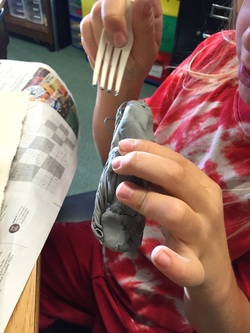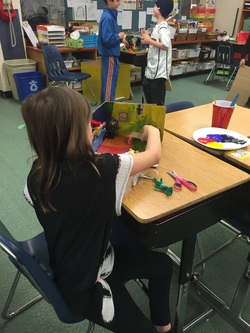Instruction & Management Plan
This unit focuses on architecture and the characteristics and expressive features involved. We will be learning about different spaces and things that occupy that space. This unit was created after our first lesson of getting to know the students. Many students made it apparent that they were interested in environments, characters, and stories. This unit consists of 3 lessons that are described below:
Lesson 1: Lesson 1 focuses on the students creating a character/creature. Several topics were introduced to the students such as planning, ideation, artistic expression, and the artistic process. Students learned basic clay techniques including coil building, slipping and scoring, and pinch pots. They were also presented with basic clay tools including an extruder, loop tools, and forks for scratching.
Lesson 2: Lesson 2 focuses on students creating a space for their character/creature to live in. This lesson’s goal was to create a painting depicting space. Students used, ideation, paint, and found materials to create their painting. Students focused on color mixing, space, line, artistic process, and artistic intention. They were introduced to the tools of paint brushes and found materials.
Lesson 3: Lesson 3 focuses on creating a 3-D model of their space and then building a city. The goal of this lesson is to create a model of the space that their character will inhibit. The students will then take their environments and collaborate with other students to create their own city. This lesson focuses on space, line, scale, modeling, transferring, and making connections. Students will be presented with the art of sculpture and using found objects. They will be manipulating found objects into new items.
Several activities were incorporated into our unit in order to integrate literacy, numeracy, and technology. Literacy was incorporated into every lesson. The main component of literacy was in-progress critiques. These critiques were one-on-one discussions between the students and the teacher. These discussions involved talking about the student’s decisions and questioning what would happen next in their art. Numeracy is also something that was incorporated. Numeracy is seen in many parts of this unit but especially when the students had to build 3-D furniture and objects for their space. Some students used rulers while others measured with pieces of cardboard. Technology was incorporated when the teachers gave presentations. We used research and images form online to show students current art. We also used videos from the internet that would demonstrate certain techniques or ideas.
A variety of strategies were used for classroom management in this unit. The organization of the classroom worked very well for our lessons. Students were separated into groups of 3-4 desks. There was a large open space in the front of the room that worked very well for watching videos and presentations as well as giving directions and discussions. One important safety we took during this unit was the hot glue guns. There are some students we thought would use them responsibly but others that we thought would not use them correctly. For that reason we set up a hot-glue station during the 3-D days that was run by one of the teachers. Although there were sometimes lines of 3-4 students, we felt that it was safer to have an adult handle the hot glue gun. Clean up was organized by assigning jobs to students. Typically I categorized the cleaning jobs into 4 groups. Those 4 groups were floor duty, table washers, material table organizer, and sketchbook collector. After those jobs were attended to, the students were responsible for putting their projects away and any other messes that were specific to their on project. When discussions happened in the classroom, they were typically gallery walks. Students would set out their final projects once everything had been cleaned up and we would let the students explore all the projects. Once the students had a chance to explore all the projects we would gather as a group and ask the students to raise their hand and tell us one that they wanted to look at more closely and why they wanted to.
Lesson 1: Lesson 1 focuses on the students creating a character/creature. Several topics were introduced to the students such as planning, ideation, artistic expression, and the artistic process. Students learned basic clay techniques including coil building, slipping and scoring, and pinch pots. They were also presented with basic clay tools including an extruder, loop tools, and forks for scratching.
Lesson 2: Lesson 2 focuses on students creating a space for their character/creature to live in. This lesson’s goal was to create a painting depicting space. Students used, ideation, paint, and found materials to create their painting. Students focused on color mixing, space, line, artistic process, and artistic intention. They were introduced to the tools of paint brushes and found materials.
Lesson 3: Lesson 3 focuses on creating a 3-D model of their space and then building a city. The goal of this lesson is to create a model of the space that their character will inhibit. The students will then take their environments and collaborate with other students to create their own city. This lesson focuses on space, line, scale, modeling, transferring, and making connections. Students will be presented with the art of sculpture and using found objects. They will be manipulating found objects into new items.
Several activities were incorporated into our unit in order to integrate literacy, numeracy, and technology. Literacy was incorporated into every lesson. The main component of literacy was in-progress critiques. These critiques were one-on-one discussions between the students and the teacher. These discussions involved talking about the student’s decisions and questioning what would happen next in their art. Numeracy is also something that was incorporated. Numeracy is seen in many parts of this unit but especially when the students had to build 3-D furniture and objects for their space. Some students used rulers while others measured with pieces of cardboard. Technology was incorporated when the teachers gave presentations. We used research and images form online to show students current art. We also used videos from the internet that would demonstrate certain techniques or ideas.
A variety of strategies were used for classroom management in this unit. The organization of the classroom worked very well for our lessons. Students were separated into groups of 3-4 desks. There was a large open space in the front of the room that worked very well for watching videos and presentations as well as giving directions and discussions. One important safety we took during this unit was the hot glue guns. There are some students we thought would use them responsibly but others that we thought would not use them correctly. For that reason we set up a hot-glue station during the 3-D days that was run by one of the teachers. Although there were sometimes lines of 3-4 students, we felt that it was safer to have an adult handle the hot glue gun. Clean up was organized by assigning jobs to students. Typically I categorized the cleaning jobs into 4 groups. Those 4 groups were floor duty, table washers, material table organizer, and sketchbook collector. After those jobs were attended to, the students were responsible for putting their projects away and any other messes that were specific to their on project. When discussions happened in the classroom, they were typically gallery walks. Students would set out their final projects once everything had been cleaned up and we would let the students explore all the projects. Once the students had a chance to explore all the projects we would gather as a group and ask the students to raise their hand and tell us one that they wanted to look at more closely and why they wanted to.



